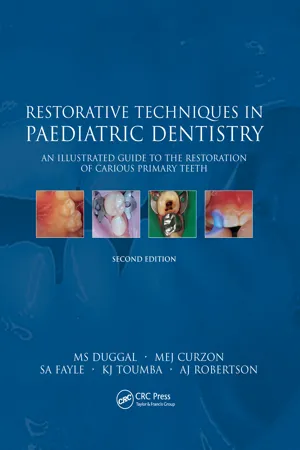
eBook - ePub
Restorative Techniques in Paediatric Dentistry
An Illustrated Guide to the Restoration of Extensive Carious Primary Teeth
M.S. Duggal,M.E.J Cuzon,S.A. Fayle,K.J Toumba,A.J. Robertson
This is a test
- 152 pages
- English
- ePUB (mobile friendly)
- Available on iOS & Android
eBook - ePub
Restorative Techniques in Paediatric Dentistry
An Illustrated Guide to the Restoration of Extensive Carious Primary Teeth
M.S. Duggal,M.E.J Cuzon,S.A. Fayle,K.J Toumba,A.J. Robertson
Book details
Book preview
Table of contents
Citations
About This Book
This was one of the first books on the market to illustrate the various clinical techniques for restoration, which is increasingly favored over extraction for primary teeth. A revised and updated edition of this successful text offers, in addition, new material on plastic restorations. Restorative Techniques addresses the specific needs of the pediatric patient, and it helps the clinician manage the restoration with those needs in mind. As a classic volume, it is essential for every dentist, particularly those who work with children and adolescents and particularly those who perform restorative dentistry.
Frequently asked questions
How do I cancel my subscription?
Can/how do I download books?
At the moment all of our mobile-responsive ePub books are available to download via the app. Most of our PDFs are also available to download and we're working on making the final remaining ones downloadable now. Learn more here.
What is the difference between the pricing plans?
Both plans give you full access to the library and all of Perlego’s features. The only differences are the price and subscription period: With the annual plan you’ll save around 30% compared to 12 months on the monthly plan.
What is Perlego?
We are an online textbook subscription service, where you can get access to an entire online library for less than the price of a single book per month. With over 1 million books across 1000+ topics, we’ve got you covered! Learn more here.
Do you support text-to-speech?
Look out for the read-aloud symbol on your next book to see if you can listen to it. The read-aloud tool reads text aloud for you, highlighting the text as it is being read. You can pause it, speed it up and slow it down. Learn more here.
Is Restorative Techniques in Paediatric Dentistry an online PDF/ePUB?
Yes, you can access Restorative Techniques in Paediatric Dentistry by M.S. Duggal,M.E.J Cuzon,S.A. Fayle,K.J Toumba,A.J. Robertson in PDF and/or ePUB format, as well as other popular books in Medicine & Medical Theory, Practice & Reference. We have over one million books available in our catalogue for you to explore.
Information
Children as individuals
A treatment plan must be developed and designed to provide high-quality restorative care for each individual child’s needs. The details will vary according to the types of restorations needed, as will the sequence of placing restorations.
In this book the objective is to provide an atlas describing the techniques for the restorative care of children, and therefore the approach to treatment planning is very much orientated to that end. It is accepted that every child will require some degree of preventive dentistry and behaviour management, but these subjects will not be covered here.
Quality care for children
Children are the future dental patients and the dental care that they receive should therefore promote positive dental experiences, which, in turn, promotes positive dental attitudes. It makes disturbing reading when some dental professionals, particularly in the UK, question whether children’s teeth should be restored at all. We feel that this type of thinking, promoted usually by some public health dentists, rather than paediatric dentists, is more to do with economics than conviction. There can be no doubt that untreated caries in the primary dentition can cause abscesses, pain and suffering in children. Indeed, hospital-based consultants in paediatric dentistry frequently deal with patients referred to them with severe infections related to long-standing untreated caries in the primary dentition of children who have had regular check-ups with their dentist (Figure 1.1). These children then require hospital admissions and treatment under general anaesthesia, whereas a simple restoration at the time when the caries was diagnosed would have prevented this extremely distressing episode for the child. There are also implications for costs of carrying out this hospital-based treatment, which is substantially more than the cost of simple restorative and preventive treatment. In addition, a negative dental experience for a young child could alter their attitude to dentistry and dental health for life. It is therefore essential for all dentists involved in the care of young children to learn restorative techniques that give the best results in primary teeth. This approach, alongside excellent preventive programmes, would form the basis of ‘quality dental care for children’, which this book seeks to promote. Good quality restorative care, as and when caries is diagnosed, would also obviate the need for extractions of primary teeth under general anaesthesia for thousands of children, particularly in the UK, a practice that should have only a small place in the dental care of young children.
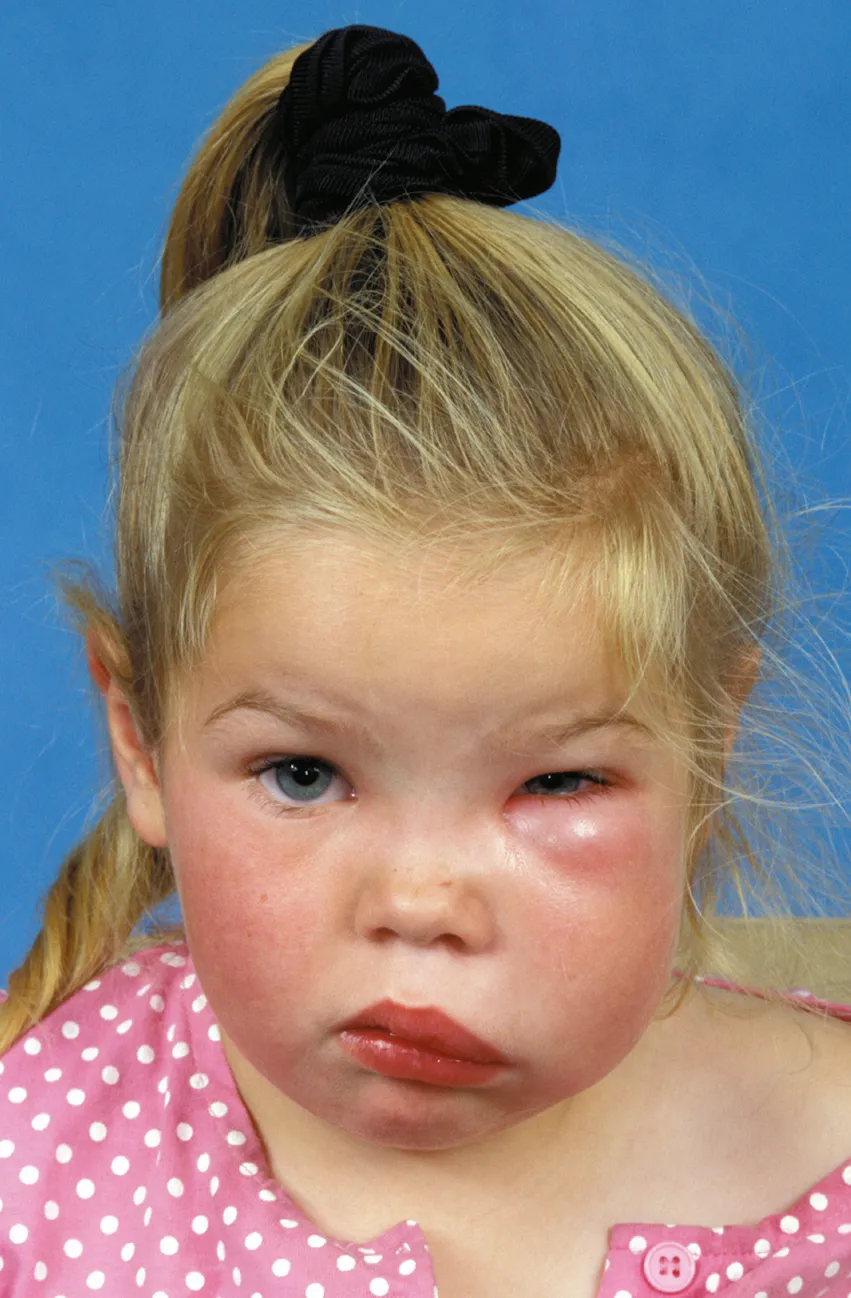
Figure 1.1 Photograph of a young child with severe infection resulting from an unrestored carious upper second primary molar.

Figure 1.2 Dental history form.
Philosophy of treatment planning
In planning for the restoration of teeth, allowance must be made for two types of children. The first will be those for whom no restorative care has been attempted in the past, but who now do need it. For these children a sequenced introduction to the procedures of restoring teeth is needed. Treatment planning for them must include a step-by-step introduction to the use of pain control (local analgesia), use of rotary instruments, rubber dam and the placing of restorations. The time needed for this introduction may be anything from a few minutes to several visits.
Most children will not normally be afraid, and one of the important aspects of providing care for them will be to ensure that they do not develop a fear of dentistry.
The second group of children comprises those who may already have had some restorations or perhaps attempted restorations. With these children there may be a history of being totally uncooperative or only reluctant to cooperate but persuadable. In such cases the treatment planning must take into account the degree of cooperation and again an amount of time allowed for behaviour modification.
In this atlas it is assumed that a child is cooperative or that cooperation has been obtained.
The technique of treatment planning is to obtain all the necessary information on the dental history and dental status of a child. Using this information, a plan of dental visits is drawn up so as to complete the restorative care needed in the shortest possible time appropriate for that child. It is our philosophy that the ideal approach for restoring children’s teeth involves the practice of quadrant dentistry.
Diagnosis
The dental problems of a child must be assessed before a treatment plan is designed. This involves not only examining the teeth but also assessing the child’s behaviour. This should start before the child has entered the dental office and should begin by observing the child with his or her parents or carers in the waiting room. As the family enter, the child’s behaviour and relationship with parents or carers should be observed. It is at this stage that any apprehension or difficult behaviour should be noted, since it will affect the sequence of restorative procedures and hence the treatment plan.
A history should be taken from the parents, including details of previous behaviour, restorations or attempted restorations. In addition, the parents should be asked if previous restorative work has been with or without local analgesia and rubber dam. Any previous history of extractions, again with either local analgesia or general anaesthesia, should be noted. These details should be recorded on a dental history form (Figure 1.2).
The first visit will include a simple examination of the dentition, with an assessment of the extent of dental caries, oral hygiene, gingivitis and periodontal disease. All oral tissues should be examined for health and possible pathology. Before restorative care is started, the oral hygiene should be of a good standard, and the child’s behaviour should have been assessed and measures taken to ensure cooperation.
Dental caries assessment
For the restoration of primary and young adult teeth, the extent of dental caries must be known. A clinical examination with a dental mirror and good lighting is required, with a dry field. The presence of all carious lesions and restorations must be recorded on a suitable dental chart. If available, transillumination is also helpful.
In particular, the following should be noted about the dental caries in each tooth:
• staining of pits and fissures;
• discolouration of the enamel;
• condition of the marginal ridge, whether intact or broken (Figure 1.3).
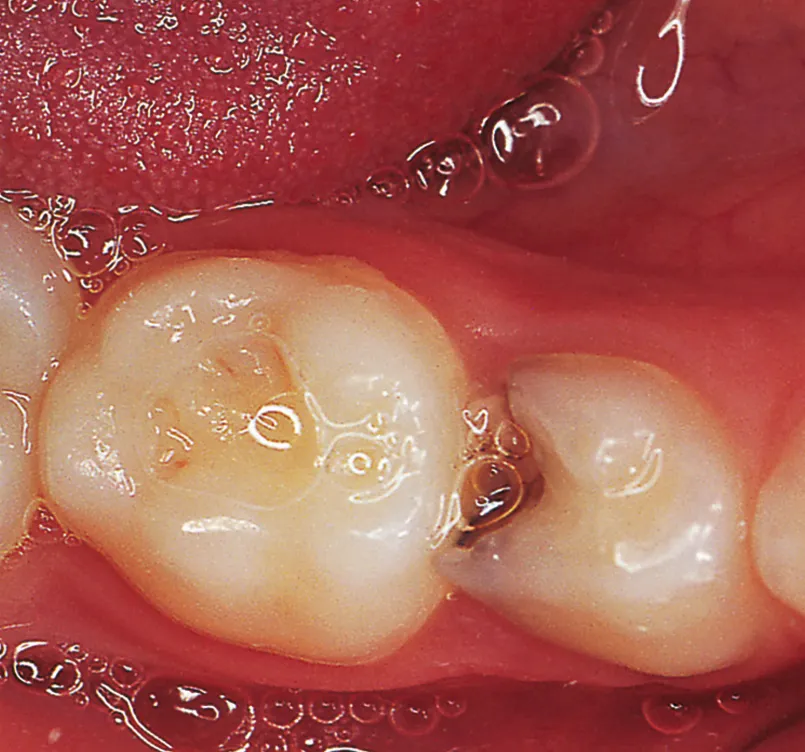
Figure 1.3 Photograph of primary molars showing broken marginal ridge. Where over one-third of the marginal ridge has been lost, pulpal involvement has occurred and pulp treatment (pulpotomy or pulpectomy) should be planned (see Chapter 4).
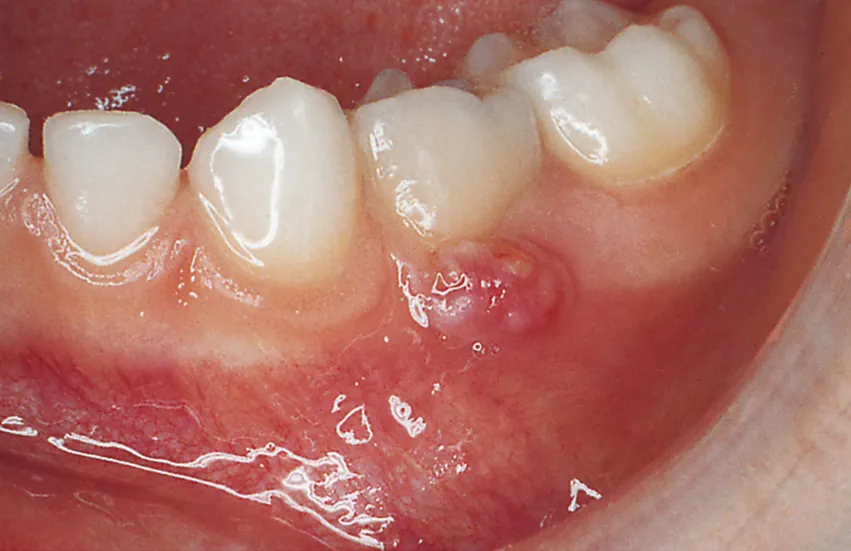
Figure 1.4 Photograph of primary molars showing a draining sinus on a first primary molar with a failed glass ionomer restoration. This tooth must be treated with a pulpectomy (see Chapter 4).
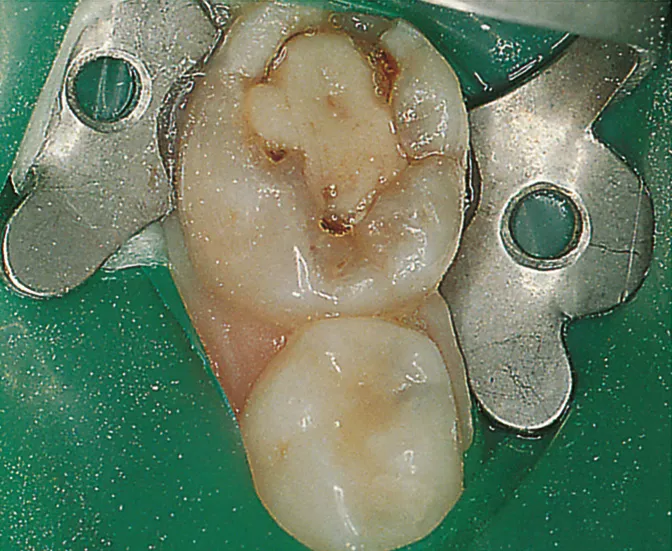
Figure 1.5 Photograph of a primary molar with a failed glass ionomer cement restoration, now requiring pulp treatment and a preformed metal crown (see Chapters 4 and 5).
At the same time, the presence of chronic or acute abscesses should be noted, as well as draining sinuses, which would indicate pulpal pathology (Figure 1.4).
Existing restorations should be examined with care for recurrent caries and for the type and integrity of the restorations. In particular, glass ionomer cements and composite resin restorations should be examined most critically, since their success rates in primary teeth are poor and they often need replacement. An example of a poor quality glass ionomer restoration in a primary molar that has failed is shown in Figure 1.5. Too often, an attempt is made to restore a large cavity in a primary tooth with a material that will not hold for very long. Leakage around the margins or breakdown of the margins leads to failure of the restoration. In many cases the cavity was originally quite deep, and irreversible pulpal necrosis occurs when the tooth dies and an abscess ensues. This is the situation illustrated in Figure...
Table of contents
Citation styles for Restorative Techniques in Paediatric Dentistry
APA 6 Citation
Duggal, M., Cuzon, M., Fayle, S., Toumba, K., & Robertson, A. (2021). Restorative Techniques in Paediatric Dentistry (2nd ed.). CRC Press. Retrieved from https://www.perlego.com/book/2352945/restorative-techniques-in-paediatric-dentistry-an-illustrated-guide-to-the-restoration-of-extensive-carious-primary-teeth-pdf (Original work published 2021)
Chicago Citation
Duggal, M, M Cuzon, S Fayle, K Toumba, and A Robertson. (2021) 2021. Restorative Techniques in Paediatric Dentistry. 2nd ed. CRC Press. https://www.perlego.com/book/2352945/restorative-techniques-in-paediatric-dentistry-an-illustrated-guide-to-the-restoration-of-extensive-carious-primary-teeth-pdf.
Harvard Citation
Duggal, M. et al. (2021) Restorative Techniques in Paediatric Dentistry. 2nd edn. CRC Press. Available at: https://www.perlego.com/book/2352945/restorative-techniques-in-paediatric-dentistry-an-illustrated-guide-to-the-restoration-of-extensive-carious-primary-teeth-pdf (Accessed: 15 October 2022).
MLA 7 Citation
Duggal, M et al. Restorative Techniques in Paediatric Dentistry. 2nd ed. CRC Press, 2021. Web. 15 Oct. 2022.